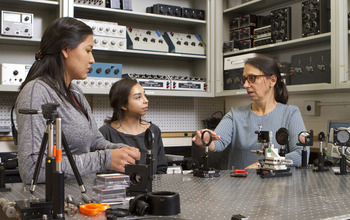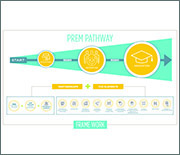News Release 18-056
NSF awards forge partnerships between minority-serving institutions and leading research facilities
8 research collaborations receive grants to increase diversity in materials research

Fort Lewis College engineering students work in the laboratory with Megan Paciaroni.
August 7, 2018
This material is available primarily for archival purposes. Telephone numbers or other contact information may be out of date; please see current contact information at media contacts.
The National Science Foundation (NSF) has awarded new Partnerships for Research and Education in Materials (PREM) grants to support eight collaborations across the United States aimed at fostering cutting-edge materials research while increasing diversity.
Each award is expected to total nearly $4 million and will support a materials research partnership between a minority-serving institution (MSI) and a large-scale research facility supported by NSF's Division of Materials Research (DMR).
The PREM partnerships will provide pathways for recruitment, retainment and degree-attainment of underrepresented minorities in materials research professions across the country.
"The United States benefits from greater innovation and a more diverse materials workforce, one that will drive cutting-edge innovations in the decades to come," said Linda Sapochak, director of NSF's Division of Materials Research. "Now in its second decade, PREM brings innovative research teams that may lack the resources of larger institutions into fully reciprocal collaborations with some of NSF's leading materials research facilities."
The PREM pathway encourages a diverse cohort of young scientists and engineers to stay in materials research through graduation and move on to pursue higher education and rewarding careers in the field. The new class of awardees will receive support for six years -- one year longer than previous awardees.
Since its launch in 2004, PREM has successfully diversified research faculty while improving the likelihood that participating students will go on to complete a doctorate in materials research. The initiative has yielded a wide range of results with applications from potential cancer treatments to novel solar cells. Since its inception, PREM has trained 109 postdocs and graduated 427 graduate students and 793 undergraduate students, most from underrepresented minority groups.
The 2018 PREM awardees are:
The California State University, Northridge and Princeton University Center for Complex Materials, which is an NSF Materials Research Science and Engineering Center (MRSEC), will focus on such fundamental challenges as the energetics and dynamics of excited states in quantum materials, the spontaneous fractional topological quantum Hall effect, fractional topological physics in periodically driven systems, and computational discovery of novel topological materials. The project's PREM framework elements will include hosting research symposia for postdoc and students, summer nanoscience camps for high school teachers, summer research programs for undergraduate students at Princeton and a Materials Research Day (Dia de la Ciencia) for high school students.
The Fort Lewis College and Norfolk State University STROBE Science and Technology Center will focus on advanced imaging and characterization of functional nanomaterials. Fort Lewis College is a Native American-Serving Nontribal Institution, and additionally serves a significant Hispanic population. The PREM framework elements of this project will provide undergraduate students access to research mentors, guided research experiences, professional development activities, a peer support network and leadership opportunities.
The Wisconsin-Puerto Rico Partnership for Research and Education in Materials connects three University of Puerto Rico campuses with the University of Wisconsin, Madison and will focus on the synthesis, characterization, modeling and application of multifunctional materials. The PREM framework elements will include education and outreach activities building upon those developed by the NSF MRSEC Interdisciplinary Education Group and the internationally acclaimed University of Puerto Rico Science on Wheels Educational Center. Research-inspired programs will define a pathway that recruits, retains and advances people from all stages of the pipeline (K-12 through faculty) into STEM fields throughout Puerto Rico and Wisconsin, with a focus on Hispanic Americans and women.
The Jackson State University and University of California, Santa Barbara Partnership for Research and Education in Materials Research will focus on developing novel 2D and 3D hierarchical materials, such as bio-inspired 3D nanocomposites with superior mechanical strength and toughness. The project's PREM framework elements will include educational and outreach activities, such as a cooperative materials research doctorate program, an undergraduate materials research intern program, PREM summer school for K-12 students, entrepreneurship education workshops, and NanoDay events at local high schools, the Mississippi Museum of Natural Science and the Memphis Zoo.
The University of Texas at El Paso and University of California, Santa Barbara Center for Energy and Biomaterials will focus on interfacial structures and the physics and chemistry of defects and doping elements in energy materials and biomaterials. The project's PREM center will include two Interdisciplinary Research Groups with faculty from both institutions, implementing PREM framework elements, such as hands-on laboratory experience, research mentoring, professional development, research seminars, joint workshops and student exchanges.
The Tuskegee University and University of Nebraska-Lincoln Partnership for Research and Education in Multiferroic Polymer Nanocomposites will establish a research program in the emerging field of polymer nanocomposites to develop such materials for structural, energy and sensing applications. This project's PREM pathway will increase the number of African American graduates in this new field of materials research and engineering through exposure to MRSEC research facilities and educational activities.
The Center for Interfacial Electrochemistry of Energy Materials is a partnership among three Hispanic Serving Institutions in Puerto Rico and the Cornell High Energy Synchrotron Source at Cornell University (CHESS). The University of Puerto Rico, Rio Piedras Campus, and two primary undergraduate institutions, Universidad Metropolitana and Universidad del Turabo, will perform interfacial electrochemical studies of energy materials at the CHESS synchrotron X-ray source. This educational and research collaborative effort will train undergraduate and graduate students through PREM framework elements, such as, workshops and hands-on activities at CHESS.
The Hampton University-Brandeis University Partnership for Research and Education in Materials will focus on developing optical materials for applications in integrated photonics and biomedical devices. The overall goal of the Hampton-Brandeis PREM program is to increase recruitment, retention and graduation rates of talented minority students in materials research and engineering fields through the project's PREM pathway. The collaboration will include framework elements such as a Path-to-Professorship (PtP) postdoctoral fellowship and outreach program in materials research for middle and high school students in the Hampton Roads region.
-NSF-
-
Oxide crystals from the laboratory of Ramana Chintalapalle at the University of Texas at El Paso.
Credit and Larger Version -
Student collaborators in the laboratory of Vijaya Rangari at Tuskegee University.
Credit and Larger Version -
A 3D nanoarchitecture, based on a plasmonic hot-spot, developed by Jackson State University.
Credit and Larger Version -
The NSF PREM Pathway for encouraging diversity in materials research.
Credit and Larger Version
Media Contacts
Joshua Chamot, NSF, (703) 292-4489, email: jchamot@nsf.gov
Mario Alegre-Barrios, University of Puerto Rico, Rio Piedras, (787) 764-0000, email: mario.alegre@upr.edu
Carmen Ramos Chandler, California State University, Northridge, (818) 677-2130, email: carmen.chandler@csun.edu
Mitchel Davis, Fort Lewis College, (970) 247-7401, email: davis_m@fortlewis.edu
Maxine Greenleaf, Jackson State University, (601) 979-1328, email: maxine.r.greenleaf@jsums.edu
Mariam Ludim, University of Puerto Rico - Universidad Metropolitana, (787) 265-3879, email: mariam.ludim@upr.edu
Michael Tullier, Tuskegee University, (334) 724-4553, email: mtullier@tuskegee.edu
Pablo Villa, University of Texas at El Paso, (915) 747-6068, email: pablov@utep.edu
Matthew White, Hampton University, (757) 727-5255, email: matthew.white@hamptonu.edu
The U.S. National Science Foundation propels the nation forward by advancing fundamental research in all fields of science and engineering. NSF supports research and people by providing facilities, instruments and funding to support their ingenuity and sustain the U.S. as a global leader in research and innovation. With a fiscal year 2023 budget of $9.5 billion, NSF funds reach all 50 states through grants to nearly 2,000 colleges, universities and institutions. Each year, NSF receives more than 40,000 competitive proposals and makes about 11,000 new awards. Those awards include support for cooperative research with industry, Arctic and Antarctic research and operations, and U.S. participation in international scientific efforts.
Connect with us online
NSF website: nsf.gov
NSF News: nsf.gov/news
For News Media: nsf.gov/news/newsroom
Statistics: nsf.gov/statistics/
Awards database: nsf.gov/awardsearch/
Follow us on social
Twitter: twitter.com/NSF
Facebook: facebook.com/US.NSF
Instagram: instagram.com/nsfgov






